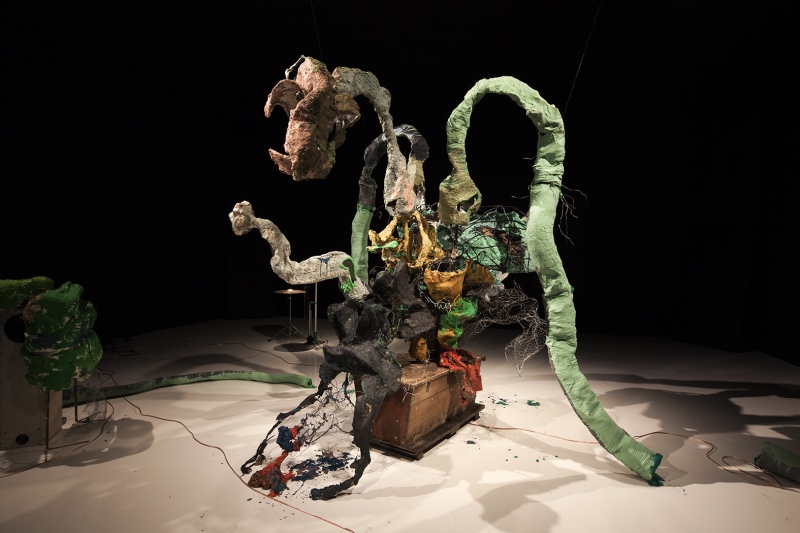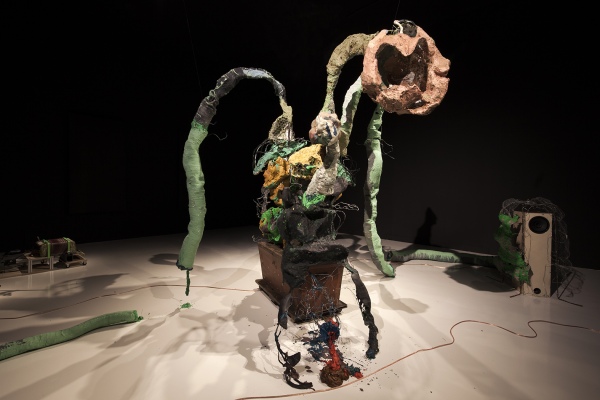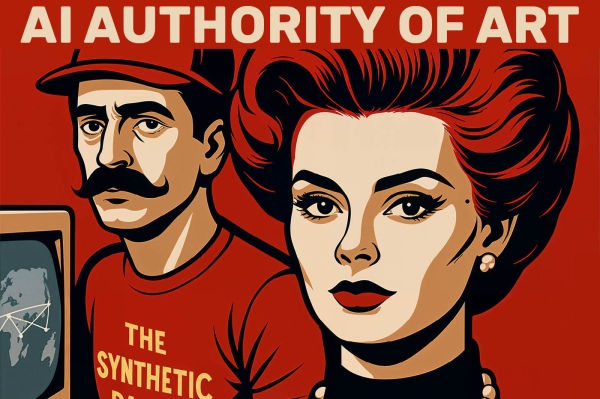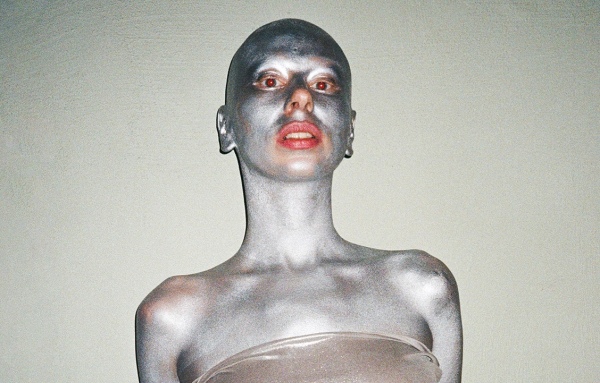talk
„You Don’t Live by the Devil Alone”
Piotr Bruch in conversation with Daria Grabowska
-
Daria Grabowska: Why art school?
- Piotr Bruch: I began arts training at the Visual Arts High School in Poznań, keen to perfect my drawing. Among the skills that school taught me were poster and book design. Generally, throughout high school, I did vocals and graphics for my death metal band, Enslavement. Playing and listening to underground music, performing and partying with a bunch of maniacs of extreme sounds - that formed me, including in artistic terms. Then I applied for Intermedia in Poznań and Multimedia in Szczecin. I went to Szczecin, where throughout almost the entire period I was based in the nearby Stargard, and there I refitted a part of my home into an art studio and a room for experiments with musical instruments. I completed the Multimedia course, majoring in experimental film.
-
Music means a lot to you. Didn’t you want to study it? Don’t you think art is too complicated to be concrete?
- I have friends who’ve been through music school and the opinion is thus: the piano lid crashes on a young player’s fingers, oftentimes, and she becomes averse to playing. The pleasure of playing has been replaced by a feeling of nausea, by trembling at the sound of the C key. Playing by notation is another matter. There are musicians who can’t play without digits, letters, or notes. Certain habits acquired at school can stifle creativity or deactivate various spheres of sensitivity, cause you to bury your heart deep in a hole hidden from yourself. I’m not saying musical education is a bad thing, almost any music school can support some and depress others. I’m interested in an approach to music and all art that comes from the heart, based on how you relate to it emotionally (instead of heeding the judgements of the music or arts professor). Contemporary art can be convoluted, remixed, deconstructed, fixated. It’s a raw sport of tricks, vested interests, certain circles, fake values, excitations, fetishes, redundant things. With music or sound, our message is immediate, we hear it the moment we produce it. Sound is fast, ready to be articulated suddenly, caused by energy, body, emotions, method, nothing, or absence of sound.
-
So art and music.
- Yes. My other activities are sound projects, I play solo as Rito Primitivo. With Artur Malewski, we make music as Martwychwstaniec and Ur.zm.ur. We typically hold recording sessions around All Souls Day. We generally compile tracks of percussions, vocals, folk instruments, electronics etc. Our principles are: no lyrics, no theme, non-human friendly.
- I like sound because it’s fast and fun. It finds application in many fields. A film or animation can be made on the basis of a soundtrack alone. Usually I first draw and write down the concept. When I’ve gathered some, the process begins of developing a common denominator or overarching formula for them that will integrate them into a single whole.
-
It’s funny, our duo. I personally have no sense of rhythm at all, music somehow escapes me, I’d rather sit in silence than assault myself with sound. You in turn are a very quiet person, but surround yourself with extreme music.
- Daria, there are a lot of sounds in silence too, but at low decibels and frequencies. True, from time to time I like to relax by listening to noise: whirrs, bangs, buzzes, the sounds of amplifiers, industrial tools, and similar walls of sound. I also find peace when staying in nature with my partner, or when making a campfire. In the past I used to party at graveyards or amid ruins.
-
You gained recognition with your project shown in the Gdańsk Academy of Fine Arts’ Best Diploma 2019 competition.
- The series You’ll Die consists of three objects: pieces of furniture or other household articles pierced with steel reinforcement rods. Around the rods I wove a wire-and-mesh frame, onto which I then transferred swathes of rolled-out plasticine as skin for the sculpture. For example, by the child table, a genre scene takes place: three small cannibals devour the guts of a great scum, which defecates its last breath into its cut-off head. From the surface of the box grows out a Japanese toxic fungus, with a sandworm emerging from its crown. Inside there’s a trapped botfly, topped with a cut-off head. The title was inspired by my finding in the basement of a workbench with drawers, on the left side of which was a primitive drawing of the torso and skull of a human skeleton, plus a heading: “You’ll die.”
- My graduation project in Experimental Film is a work called Pointless Sodomy. I’d managed to amass enough metal junk in my basement to be able, ahead of their utilization, to make recordings of atonal salvos of junk crashing down from the henhouse roof against a green-screen background. In the video, fruit and vegetables explode, junk comes down crashing, parts of domestic appliances crash down, there’s wood chopping, bowed cymbals, bowed guitars, bowed metal, apples splash against an invisible wall, watermelons and pomegranates are crushed with a shaft. It’s all-out gore vegetarian destruction.
-
You don’t eat meat?
- I’m not some vulgar anti-meat advocate. I sometimes eat a chicken-broth soup when visiting relatives. But I’ve been vegetarian by choice for some ten years now. I decided I didn’t need, I stopped, and that’s it. My blood group doesn’t need meat either.
-
You’re informed by film, books, and, last but not least, music.
- I watched Cinema of Transgression films and some Japanese and Far-Eastern flicks by Shin’ya Tsukamoto and Shizon Fukui. I love Polish cinema (1950s to the 1990s). As far as music is concerned, it’s been mainly genres like no music, harsh noise, grindcore, goregrind, gorenoise etc., i.e. extreme music, not for everyone. But I don’t confine myself to heavy sounds. I also listen to minimal music – S. Reich, M. Nyman, J. Cage – or, for a change, to noir (Bohren & der Club of Gore). More serious stuff, Penderecki or Stravinsky, is on the list too because you don’t live by the devil alone. Pop culture has a huge impact on the perception of meanings. I observe and draw on various cultures. I see how technology can be used to flatten, devaluate, or deconstruct information. Meanings are juggled, distorted, and shifted, and as the media stimulations and communications pile up endlessly, the original meaning is ultimately lost. Sometimes I watch disco-polo music on TV and play some goregrind to that, watching how, as aesthetic opposites, sound and image try to integrate.
-
You’ve combined all that in the Project Room.
- I came up with the idea for Prey when observing natural phenomena that are microscopic, seldom noticed. What fascinates me in the micro-world is the uncompromising behaviourism of insects, saprotrophes, decomposers, parasites, all kinds of phages. These are organisms that consume dead tissue, which makes them useful, because dead tissue is energized by other organisms. Some of these creatures are coprophagic, they consume faeces, which I relate to humanity. We feed on refuse, useless detritus, leftovers of information, devouring the trash of TV and the Internet.
-
The installation is accompanied by what you call a “wall of sound” and “percs.”
- The wall of sound was produced using two mechanical instruments that play at the same time, producing a textural mass of sound. Something like drone music, long sustained tones. One of the instruments is a bow, its horsehair ribbon rubbing against the edge of a percussion cymbal, the other is a self-playing accordion. The industrial mechanical instruments are accompanied by a Last-Days-of-Humanity-on-fly-agaric kind of track, a composition that includes vocals, percs, in this case mainly percussion blasts, i.e. sixteenth and thirty-second notes on the snare and bass drums, as long, fast, and monotonous percussive phrases. All these elements that I’ve mentioned sound together like a single mass of sound. Their sum total emits from DIY speakers. Their front have been made with parts of a bed my late grandfather slept in.
-
Do you see a connection between the work’s idea and where it’s presented?
- My intention was to make an installation large enough so that it not so much conveyed the work’s idea as spread around the Project Room’s sizeable space itself. Its dimensions partly determined the size of the components. Besides that, the install was to spew out sonic noise in order to tickle visitors with violent sounds, not necessarily pleasant ones, but present nevertheless in the urban landscape. An atmosphere of industrialization and overstimulation with flickering moving images and noise accompanies cities, but does that give us a sense of calm?
-
Did you see the previous Project Room shows?
- I remember Natalia Janus-Malewska’s May the Shadow of the Sun Fall on a World at Peace, which impressed me with the way it claimed the entire space. It was like entering an arena. I felt the presence of a great cat in the shape of its paw prints in the sand that separated off the visitor and limited the ways in which you were able to move around the space and experience the work. I appreciate the minimalism, and at the same the maximalism, of the artistic media used here.
- I also participated in Horacy Muszyński’s project for the Project Room, contributing special audio effects from my collection to two episodes of his mockumentary series.
-
The Polish art field also has a lot activism, a.k.a. political commentarism.
- Participatory artworks that present the participant with a discomforting experience can, I believe, make sense. People don’t like changing their habits, leaving their comfort zone, their familiar territory, don’t like exploring their fears and probing their unconscious. But we deceive ourselves every day with the pulp of subliminally coded TV, news, infotainment, stimuli, moving images in all kinds of media – such pulp we gorge ourselves with till our pineal gland calcifies. The Japanese noise band Hanatarash staged „danger music” happening-like live shows, for example, at one venue their frontman, Yamantaka Eye, drove through the back wall and onto the stage in a bulldozer. I’ve never been to such a happening, but I realize that a powerful re-enactment with audience participation, where the participating citizen experiences discomfort similar to that experienced by people around the world, in various social situations, can help you understand the situation of some individuals, where things are bleak and it’s even hardly possible to escape. I think that showing social diversity, like Oscar Massotta did in his performances, where people from the lower classes were blinded with stroboscopic light and spattered with fire-extinguisher foam, with the rest of the audience only watching, is an oppressive and shocking way, but can it always open people’s eyes?
-
What do you think about Warsaw and the scene here? Do you prefer larger or smaller cities?
- I don’t know the Warsaw scene closely enough to have a specific opinion. I don’t care so much about the dominant trends or styles, especially in the art world. I’ve lived in the underground so far, outside the spotlight. The size of a city doesn’t matter so much as the people, locals, family, a simple sense of belonging and being needed somewhere, that’s what makes sense for me and that’s what I search for.
-
You build the plasticine installations yourself, but with other elements it’s a larger effort.
- If I have the funds to produce a more complex installation, I gladly collaborate with my colleagues from Poznań, who work professionally with robotics, machine design and so on. I guess collaboration can be the essence of work. A desire to materialize an idea that combines different disciplines of science produces tangible effects. It’s also a creative challenge for my engineer pals from Rataje.
-
In Prey, everything comes apart, melts away, giving the impression of utter disintegration.
- At the art high school they taught me how to correctly paint and draw. I don’t know what it means to execute something poorly or well. You can also attain perfection in developing a method of drawing incorrectly. An ability to use your own language builds an aesthetic. Then making a poor drawing can be representative for the author’s expression, their power, expressed through the medium and style, to produce a unique work. A well- or correctly- executed drawing can be replete with camouflage and artifice, which in my opinion is a worse thing, less valuable, than a genuine, honest, and frank attitude to work. Pricasso.
-
Prey is is a large-scale installation. What are you going to do with after the show?
- After the show the work goes back to Stargard. It takes two cars, one carries the eight modules of the sculpture, the other the hardware, speakers, instruments. I’ll steeve the palettes with the modules in the garage. There they’ll ferment until turn decrepit or get flooded.
-
Stargard will get flooded?
- Last year the basement was flooded above ankle height, the fire-fighters came to help. The whole street has a problem with that. I live in what used to be my grandfather’s house, it was built in 1935 and there was originally a special floodgate in the basement. But the water mains system was modernized after the war in a way that ignored the specificity of the original infrastructure. An upgrade is needed for the house to function as it should.




